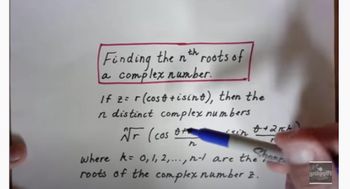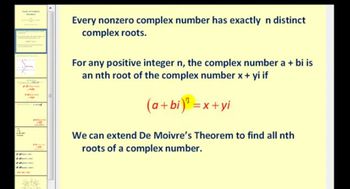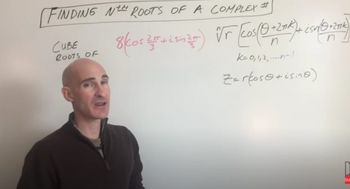Table of contents
- 0. Review of College Algebra4h 43m
- 1. Measuring Angles39m
- 2. Trigonometric Functions on Right Triangles2h 5m
- 3. Unit Circle1h 19m
- 4. Graphing Trigonometric Functions1h 19m
- 5. Inverse Trigonometric Functions and Basic Trigonometric Equations1h 41m
- 6. Trigonometric Identities and More Equations2h 34m
- 7. Non-Right Triangles1h 38m
- 8. Vectors2h 25m
- 9. Polar Equations2h 5m
- 10. Parametric Equations1h 6m
- 11. Graphing Complex Numbers1h 7m
11. Graphing Complex Numbers
Powers of Complex Numbers (DeMoivre's Theorem)
Problem 68
Textbook Question
Textbook QuestionIn Exercises 65–68, find all the complex roots. Write roots in polar form with θ in degrees. The complex cube roots of 27(cos 306° + i sin 306°)
 Verified Solution
Verified SolutionThis video solution was recommended by our tutors as helpful for the problem above
Video duration:
7mPlay a video:
Was this helpful?
Key Concepts
Here are the essential concepts you must grasp in order to answer the question correctly.
Complex Numbers
Complex numbers are numbers that have a real part and an imaginary part, expressed in the form a + bi, where 'a' is the real part and 'b' is the imaginary part. In trigonometric form, a complex number can be represented as r(cos θ + i sin θ), where r is the modulus and θ is the argument. Understanding complex numbers is essential for finding roots and performing operations in the complex plane.
Recommended video:

Dividing Complex Numbers
De Moivre's Theorem
De Moivre's Theorem states that for any complex number in polar form r(cos θ + i sin θ), the nth roots can be found using the formula r^(1/n)(cos(θ/n + k(360°/n)) + i sin(θ/n + k(360°/n))), where k is an integer from 0 to n-1. This theorem simplifies the process of finding roots of complex numbers by allowing us to work directly with their polar representations.
Recommended video:

Powers Of Complex Numbers In Polar Form (DeMoivre's Theorem)
Polar Coordinates
Polar coordinates represent points in the complex plane using a distance from the origin (r) and an angle (θ) from the positive x-axis. This system is particularly useful for complex numbers, as it allows for easier multiplication, division, and finding roots. Converting between rectangular and polar forms is a key skill in trigonometry and complex analysis.
Recommended video:

Intro to Polar Coordinates

 3:41m
3:41mWatch next
Master Powers Of Complex Numbers In Polar Form (DeMoivre's Theorem) with a bite sized video explanation from Nick Kaneko
Start learningRelated Videos
Related Practice











